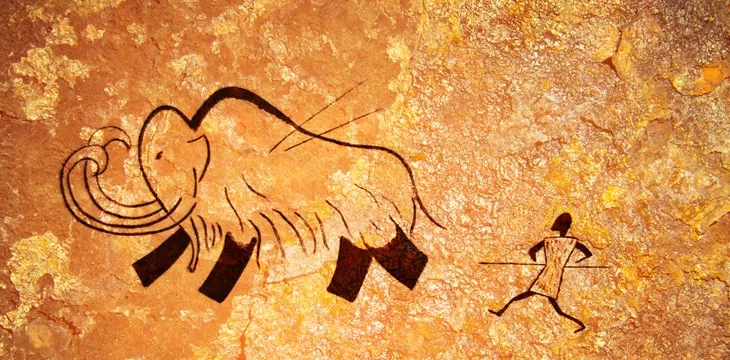|
Getting your Trinity Audio player ready...
|
How far back does history go?
As far back as we can find written records for?
As far back as we have evidence of civilization?
Or all the way back to the dawn of man?
While we have unraveled cave drawings that date back decades before the written word was invented, evidence that points to humans having the capacity to think and convey thoughts through pictures, there exists a huge gap in time between this and when the first writings were found in Sumerian clay tablets tens of thousands of years later.
What is mysterious here is that we have no history of the development of language, grammar, or civilization itself. From cave-dwelling hunter-gatherers dating back 30,000 years to the emergence of cities and modern writing, math, and astronomy in Mesopotamia in 4,000 BC, we have a complete lack of history. While some may claim that this is proof that extra-terrestrials intervened in the development of man and gave us civilization, there is simply no evidence of this, and it is equally likely that we just slowly developed ourselves through the slow migration of knowledge.
Besides, there is a whole ice age in the interim period that could have explained the crossing of people and knowledge around the globe. 25,000 years is a long time, after all. If we assume that the development of civilization was a natural progression, then why is it that we have no evidence of the progression?
Well, it could be that the same ice age that allowed people to cross continents was the same reason why we have no records of writing from this period—it simply all melted away with the ice.
This brings us to a very poignant fact and realization: History can only see as far back as the mediums on which it is recorded. Cave drawings from the ice age survived simply because they were in caves, sheltered away from erosion and damage to last 30,000 years. If civilization evolved on top of the ice, it could have all been wiped away when the ice melted or just sunk into the ocean. Could this be the reason why we only have evidence of a civilization that dates back about 8,000 years?
The great barrier of History
There is a concept in astronomy called the observable universe. It states that we can only see out into the void proportional to the volume of a sphere, the radius of which is the distance that light can travel from the time of the big bang to the present. We cannot see any further, as the light would not have had time to travel back to us to observe it. Therefore, the whole universe, which may well be much larger than the observable universe, is forever occluded from us simply because of physics. We can never see it.
In the same way, if we try to peer backward, history is occluded from our vision, the view back impeded simply by the medium in which it was recorded. So far, the best our ancestors could develop was recording on stone or clay, which may well have an average usable life of about 8,000 years. Any longer, it seems more likely than not that the information recorded on them will have been worn away and lost.
This notion that data mediums do not last forever is something that we must all grapple with in this age of information. We generate exponentially more data than all our ancient civilizations combined, and yet, we customarily store this data on mediums that are MUCH less durable than stone. SSDs last only a certain number of write cycles, magnetic storage on disks last only decades, and most of our storage mediums are subject to instant erasure from solar flares, magnetic fields, or EMP attacks. What we currently use as ‘archival’ mediums, CDs only last around 100 years—tapes a bit longer, but also suffer from instant destruction from magnetic fields. All in all, even though we create a lot more data, we are doing a worse and worse job of preserving it. For all of our technological advancements, the best form of data storage to date is still something that is thousands of years old… paper.
But there is one advantage that digital storage has over the paper, one that might mitigate all of the other shortcomings: it can be copied efficiently. While paper may last a lot longer, copying data from paper still is time-consuming if you consider the amount of information that paper can store vs. electronic mediums. The benefit of being readily copyable is immense. It costs almost no time and energy to duplicate digital data from one medium to another, not to mention there are plentiful amounts of electronic storage available in the world, and they are all conveniently connected together through a wonderful invention of interconnectivity called the internet.
What enabled was the ability for data to ‘move’ throughout this network of storage devices, connected by wires and airwaves, and ensure that even though any copy of itself could be inadvertently destroyed, it would still survive in another location. In a way, the internet acts much like the glaciers during the ice age. It allowed knowledge and people to pass freely around the globe so that the invention of language, writing, numbers, and astronomy spread far and wide, such that even with the extinction of one civilization on one side of the globe, essentially the same knowledge would live on on the other side, thus ensuring the forward evolutionary process of mankind… as if moved by an invisible hand.
So are we any better off than our ancestors? Will the humans 10,000 years in the future only be able to see back as far as the year 2000 and know of nothing more prior due to the natural movements and machinations of this small pale blue dot? I do not think so. And it isn’t because we are not writing things in stone.
It is because we now, most recently, have invented blockchain technology, and with it comes the biggest innovation: the ability to attach value to data. The fusion between money and data gives information about ‘life.’ Up to this point, it had all the environment required to sustain life—a medium in which it could live, move, and replicate… in the form of the internet and computers, but until now, it did not have a ‘motivation’ to grow, move, copy, and replicate.
But with this recent invention, data with value will certainly be stored many times more than data that isn’t valuable. With value attached to it, linking it to our physical world economics, data can be thought of like the ‘selfish genes’ in Richard Dawkins’s book, the ‘eternal replicators’ which co-opt us humans as simply vehicles by which they can replicate themselves, and ensure their survival over millennia to come, perhaps more.
For the first time ever, we humans may have defeated the “great barrier” of history. And future humans, perhaps tens of thousands of years later, will be able to find evidence of our civilization and to know of us, just as we know of the Sumerians as ‘the first human civilization,’ and they will likely lump us all together, as the ‘first humans’ thanks to Bitcoin.
Watch: On the very start of Bitcoin

 12-14-2025
12-14-2025 





